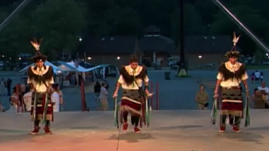Teachers' Domain - Digital Media for the Classroom and Professional Development
User: Preview



The Pollen Trail Dancers perform the Navajo Shaker Dance, also called the Buffalo Dance. Artistic director Albert Brent Chase explains that the Shaker or Buffalo Dance is a healing dance that is part of the Fire Dance Ceremony, which lasts nine nights.
This resource is part of the Native American Culture collection.
Find additional arts resources for your classroom at the KET Arts Toolkit website.
There are more than 50 different ceremonies performed by the Navajo, lasting from several hours to nine days. All involve some singing or chanting and some dance. Some are open to the public, but many are family or clan ceremonies and are held privately. Dancing is a way of honoring the connections that people have to all the life that surrounds them.
The Shaker, or Buffalo, Dance is traditionally part of the Fire Dance Ceremony, which takes place in the winter and lasts nine days. During the last two nights of the ceremony, many different kinds of dances are performed. The Buffalo Dance honors the medicine and healing powers that are within all the plants, animals, trees, mountains, and other elements of nature that surround us. The Navajo believe that if used correctly and respectfully, these elements of nature are able to heal and protect us. By respecting and honoring this healing force through ceremony and dance, the Navajo dancers keep the world in its proper balance. The Navajo name for the Buffalo Dance is Ayani bee azheesh.
The concept of dance as one part of a curing ceremony is common to many Native American cultures and must be seen in relation to the Native concept of health as “balance.” Mental, emotional, and physical health are not seen as totally separate entities but as different aspects of well-being. An individual seeks to be in a state of balance or harmony with family, clan, and tribe; with the animals, elements of weather, and other manifestations of the natural world; and with the spiritual world, according to one’s beliefs. Harmony can be disrupted not only by physical sickness but also by acts of violence. A soldier returning from war might have a curing ceremony to restore his balance and state of harmony. A criminal might have a curing ceremony as part of his rehabilitation. A person might also get out of balance through stress, fear, or grief. Sometimes simply participating in a communal dance can restore balance, and sometimes a special ceremony might be needed.
Today, some Native people follow the traditional ways of healing exclusively, and others have rejected that system totally in favor of the healthcare system of the mainstream society. There are hospitals on many reservations, and many Native Americans have become medical doctors and nurses. Many Native people today embrace the value of both systems of healing and try to put them into balance in their own lives.
 Loading Standards
Loading Standards